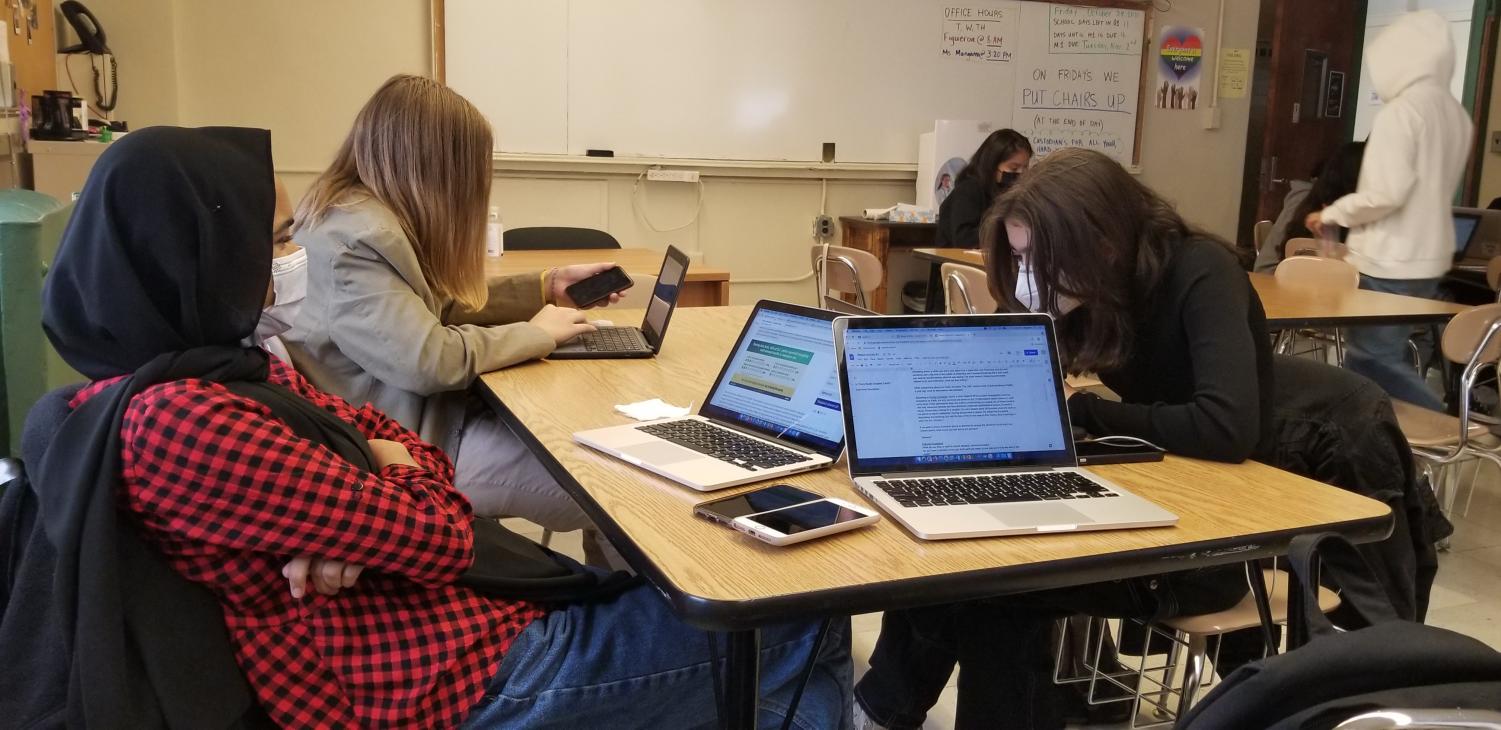Screens at the iSchool: Do they do more harm than good?
October 29, 2021
From the Smartboards at the front of every classroom to assignments being almost completely online, screens are a massive part of the school day at the NYC iSchool. Phones are used in the halls, the lunchroom, and even sometimes in the classroom.
Many students and teachers alike think that the technology-based curriculums are useful.
Sophomore Ben Edelson, who approves of the screen use policies at the iSchool, (especially the use of Google Classroom, an sort of online hub for teachers to post assignments and other information for the students,) said that “I like Google Classroom because it’s easy to see how much work I have to do and when I have to do it.”
It’s true, technology does make lessons and homework easier to access, not to mention more efficient. But is it the best option?
Some students, including freshman Matthew Marsh, prefer a more traditional way of handling assignments.
“I sort of prefer writing in notebooks, so I bought a few,” he says when asked about the iSchool’s use of Google classroom.
As well as the personal preference aspect of it, there is a more sinister reason why students might prefer to stop using screens in the classroom. Sophomore student Kevin Mosso Vidal offers a new point of view on screen use: “Kids are on their phones a lot at home, and then being on computers at school could affect their eyes and brains.”
According to an article on healthmatters.nyp.org, “Early data from a landmark National Institutes of Health (NIH) study that began in 2018 indicates that children who spent more than two hours a day on screen-time activities scored lower on language and thinking tests, and some children with more than seven hours a day of screen time experienced thinning of the brain’s cortex, the area of the brain related to critical thinking and reasoning.”
This is a massive problem, seeing as students use computers well over 2 hours every day at school alone. Actually, it’s really about five hours a day, not including screen time outside of school. According to the American Academy of Child and Adolescent Psychiatry, “children ages 8-12 in the United States spend 4-6 hours a day watching or using screens, and teens spend up to 9 hours.” This, plus the amount of screen use at the iSchool? That’s up to 14 hours a day for teens. That’s over half of a full day.
If screen time is lowering thinking and reasoning skills, the two most important tools when at school, consider how student’s grades are being affected simply by using computers and phones at school as well as at home.
But there are other problems with screens other than causing literal brain damage. Screens are also an easy distraction in a classroom. Without stricter phone policies, students will continue to use their phones during class. This is easy to conceal under a desk, allowing students to check social media, text with friends, play video games, and even cheat on tests.
According to a Harvard University article on technology use at colleges, “college students reported using their phones an average of 11 times per day in class. In another study, 92% of college students reported using their phones to send text messages during class.” The situation is largely the same for high school students as well as college students, especially at the iSchool.
Some classes allow or even occasionally require phones in class. In some classes, listening to music is allowed, or quickly accessing documents or surveys on Google Classroom can be done on a student’s phone instead of a school computer. Kahoot, a game-based learning platform used by teachers to review their student’s knowledge, can be accessed on a phone as well.
Now the question is, do the positive aspects of screen usage in school and for homework outweigh the negative aspects? The answer is that it depends. If a class requires computer use in the classroom, say for an assignment, the purpose of the computer must be clear so that the students know what they should be doing. It also depends on the class. A writing or research-based class may have more use for computers than an art class or a physical education class.
Sometimes, the use of technology, especially computers, is unavoidable in education. For over a year, schools were operating mainly online. This required students to attend class on their computers, and since the teachers could not give out paper assignments, students were required to do assignments and homework online as well.
In this situation, the opportunity for distraction is extremely amplified. According to a New York Times article, “most students will have fallen behind where they would have been if they had stayed in classrooms, with some losing the equivalent of a full school year’s worth of academic gains.”
This is largely due to the fact that students attended school while staying at home using Zoom, a video conferencing tool similar to skype or facetime. This allows students to not only use their phones during class with minimal obvious consequences, but to simply turn off their computer camera and do virtually anything they want while going undetected. While many schools require cameras to stay on and the student to remain in the frame, at the iSchool, having your camera on during a class zoom meeting was only encouraged. This caused many student’s grades to go down significantly, despite the school’s efforts to create a more natural learning environment.
Though many students at the NYC iSchool approve of the school’s more embracing approach to technology in the classroom setting, they may not be aware of the harmful effects that in-school screen time is having on their bodies, brains, and grades. If students become aware of the cons of technology in the classroom, their views on screens may change.
